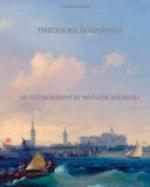when he visited Sagamore Hill. There are things
from European friends; a mosaic picture of Pope Leo
XIII in his garden; a huge, very handsome edition
of the Nibelungenlied; a striking miniature of John
Hampden from Windsor Castle; editions of Dante, and
the campaigns of “Eugenio von Savoy” (another
of my heroes, a dead hero this time); a Viking cup;
the state sword of a Uganda king; the gold box in
which the “freedom of the city of London”
was given me; a beautiful head of Abraham Lincoln given
me by the French authorities after my speech at the
Sorbonne; and many other things from sources as diverse
as the Sultan of Turkey and the Dowager Empress of
China. Then there are things from home friends:
a Polar bear skin from Peary; a Sioux buffalo robe
with, on it, painted by some long-dead Sioux artist,
the picture story of Custer’s fight; a bronze
portrait plaque of Joel Chandler Harris; the candlestick
used in sealing the Treaty of Portsmouth, sent me
by Captain Cameron Winslow; a shoe worn by Dan Patch
when he paced a mile in 1:59, sent me by his owner.
There is a picture of a bull moose by Carl Rungius,
which seems to me as spirited an animal painting as
I have ever seen. In the north room, with its
tables and mantelpiece and desks and chests made of
woods sent from the Philippines by army friends, or
by other friends for other reasons; with its bison
and wapiti heads; there are three paintings by Marcus
Symonds—“Where Light and Shadow Meet,”
“The Porcelain Towers,” and “The
Seats of the Mighty”; he is dead now, and he
had scant recognition while he lived, yet surely he
was a great imaginative artist, a wonderful colorist,
and a man with a vision more wonderful still.
There is one of Lungren’s pictures of the Western
plains; and a picture of the Grand Canyon; and one
by a Scandinavian artist who could see the fierce
picturesqueness of workaday Pittsburgh; and sketches
of the White House by Sargent and by Hopkinson Smith.
The books are everywhere. There are as many in
the north room and in the parlor—is drawing-room
a more appropriate name than parlor?—as
in the library; the gun-room at the top of the house,
which incidentally has the loveliest view of all,
contains more books than any of the other rooms; and
they are particularly delightful books to browse among,
just because they have not much relevance to one another,
this being one of the reasons why they are relegated
to their present abode. But the books have overflowed
into all the other rooms too.
I could not name any principle upon which the books
have been gathered. Books are almost as individual
as friends. There is no earthly use in laying
down general laws about them. Some meet the needs
of one person, and some of another; and each person
should beware of the booklover’s besetting sin,
of what Mr. Edgar Allan Poe calls “the mad pride
of intellectuality,” taking the shape of arrogant
pity for the man who does not like the same kind of
books. Of course there are books which a man




